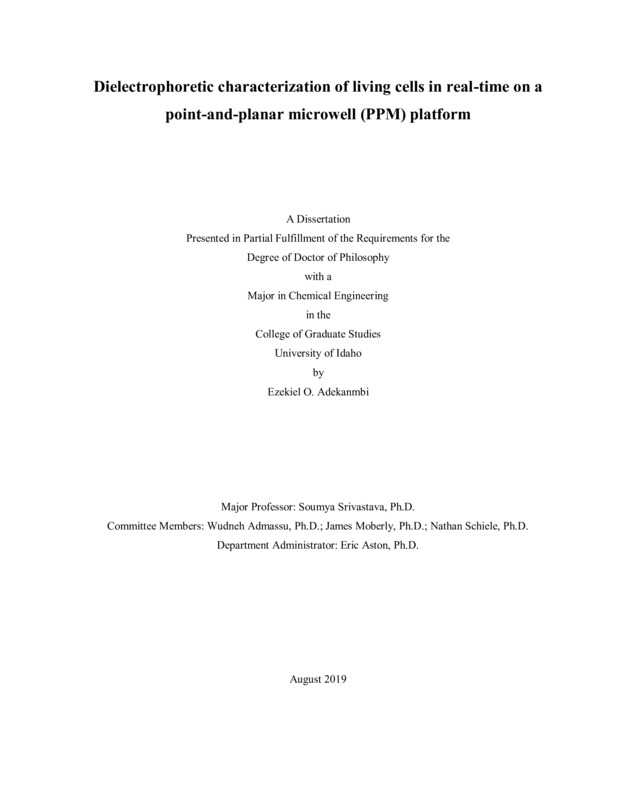Dielectrophoretic characterization of living cells real-time on a point-and-planar microwell (PPM) platform
Adekanmbi, Ezekiel Olusola. (2019-06). Dielectrophoretic characterization of living cells real-time on a point-and-planar microwell (PPM) platform. Theses and Dissertations Collection, University of Idaho Library Digital Collections. https://www.lib.uidaho.edu/digital/etd/items/adekanmbi_idaho_0089e_11661.html
- Title:
- Dielectrophoretic characterization of living cells real-time on a point-and-planar microwell (PPM) platform
- Author:
- Adekanmbi, Ezekiel Olusola
- ORCID:
- https://orcid.org/0000-0002-5103-9883
- Date:
- 2019-06
- Keywords:
- Biosorption Breast cancer Dielectrophoresis Erythrocytes PBMCs Rare Earth Elements
- Program:
- Chemical and Materials Science Engineering
- Subject Category:
- Bioengineering; Biophysics; Environmental engineering
- Abstract:
-
Electrical, dielectric, or electrophysiological properties of bioparticles, i.e. cells in particular, define their response to the external electric fields. They provide important information that aids in the prediction of bioparticle pathways, discernment of infections, phenotypic and genotypic variations, as well as pneumographic analysis, and biosensing. These dielectric properties are also essential in the development of diagnostic and therapeutic procedures. A review of the current state-of-the-art techniques for obtaining these properties was compiled and significant shortcomings ranging from cost and fabrication challenges for sub-micron bioparticles to the limitation of real-time exploration of electrode spacing were found. To address these shortcomings, a point-and-planar microwell (PPM) platform is developed. This device platform, which was fabricated with poly(dimethylsiloxane) (PDMS) polymer and assembled through a novel and economical in-house microwave plasma generator (compared and validated with commercial Harrick Plasma cleaner), is validated with O-type human erythrocytes or red blood cells (RBCs). Following validation, it was utilized for characterizing bioparticles related to applications in 1) medical diagnostics and 2) environmental biotechnology i.e. synergy of biosorption and dielectrophoresis. In medical diagnostics, the device was used to explore the properties of early stage infiltrating ductal adenocarcinoma cells (ADCs) i.e. breast cancer from peripheral blood and numerically quantifying their isolation in a microdevice using particle tracking module. This revealed the potential solution to the problem of device instability currently been experienced in the bioseparations field. The device also revealed the variations in the electrophysiological properties of human red blood cells as they age and when they are stressed. Furthermore, with the environmental challenges associated with recovering rare earth elements (REEs) and the subsequent utilization of biosorption to alleviate these challenges, this work introduces, for the first time, the utilization of dielectrophoretic crossover frequency (measured through the point-and-planar device platform) as a potential complementary quantification methodology to spectroscopy and a unique method of identifying organisms (C. Necator) that can hyperaccumulate metals (Samarium, Neodymium, and Europium).
- Description:
- doctoral, Ph.D., Chemical and Materials Science Engineering -- University of Idaho - College of Graduate Studies, 2019-06
- Major Professor:
- Srivastava, Soumya K.
- Committee:
- Admassu, Wudneh; Moberly, James; Schiele, Nathan
- Defense Date:
- 2019-06
- Identifier:
- Adekanmbi_idaho_0089E_11661
- Type:
- Text
- Format Original:
- Format:
- application/pdf
- Rights:
- In Copyright - Educational Use Permitted. For more information, please contact University of Idaho Library Special Collections and Archives Department at libspec@uidaho.edu.
- Standardized Rights:
- http://rightsstatements.org/vocab/InC-EDU/1.0/

